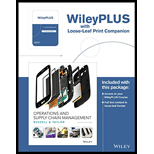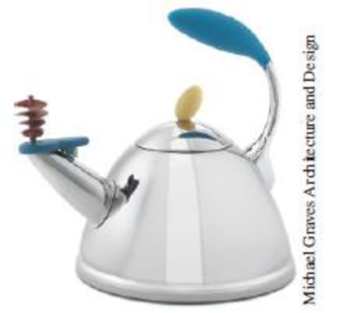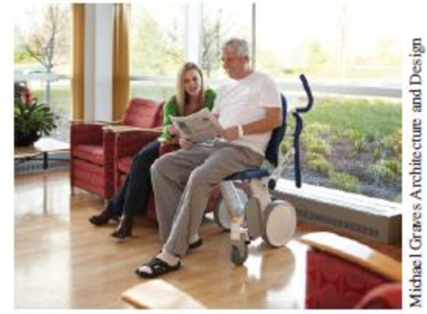
Concept explainers
Designing the Everyday
Michael Graves, probably best known for his singing teakettle sold at Target, was the first architect to have his own consumer brand of home products. His more than 800 product designs for Target helped the company differentiate itself from other big box stores and introduced the value of design to the American public. He also designed the scaffolding to protect the National Monument during major restorations, the Denver public library, walking sticks for Kimberley Clark, and more. Many years and design projects later, Graves fell ill and, wheelchair bound, turned his attention to “patient-centered health care design.”

When you think about it, the traditional wheelchair has a horrendous design. It is uncomfortable, difficult to get in and out of, hard to push and maneuver, and most egregiously, patients actually put their hands on the wheels that have been picking up debris and germs from the hospital floors to self-propel themselves. As seen in the photo, Graves’ design, produced by Stryker, has a more comfortable and cleanable molded seat with multi-formed armrests to aid entering and exiting the chair, smaller solid wheels located in the back out of reach of the patient, elevated handles and foot-operated brakes to alleviate back strain for the care provider, and a smaller footprint so multiple chairs can be stacked until needed. Attachments are not removable so they cannot be lost and are less likely to break. From the wheelchairs, Graves went on to design hospital beds and rooms, rehab centers, housing for wounded soldiers, elderly care facilities and ergonomically useful healthcare products. Although Graves passed away in 2015, the design firm that bears his name continues to win awards for patient-centered and customer-centric design.

Think about products that you use everyday. Is there a design that frustrates you or that needs a complete redesign? What ideas do you have that would improve the product for the user?
Case summary:
MG is known for his over 800 product designs. He made these designs for T, and these helped the company to differentiate itself from other big box stores. His portfolio includes the design of the scaffolding of the NM and DPL.
When he fell ill and became wheelchair-bound, he began to focus on patient-centered health care design.
The traditional wheelchair has a very cumbersome design. It is difficult to get in and out of. Patients are constantly touching the wheels to self-propel themselves. These wheels are also rolling on the hospital floors and constantly picking up dirt and germs. The conventional design is also very uncomfortable for patients. Further, it is difficult to push and maneuver.
G’ design is more advanced. The seat is molded, with movable armrests that makes it easier for patients to get in and out of. It has smaller wheels, that are out of reach of the patient. it is easier for the caretaker to use also, because it has elevated handles, and foot operated brakes which ease back strain. The chair is also more compact than conventional designs, allowing for more efficient storage.
G also went on to design hospital beds, housing for wounded soldiers, rehab centers, elderly care facilities among other things.
He passed away in 2015, but his design firm continues to win awards for customer centric design.
To determine: Is there a design that frustrates you or that needs a complete redesign? What ideas do you have that would improve the product for the user?
Explanation of Solution
Everyday use products that have a frustrating design and need a complete redesign:
A toothbrush is an everyday product that has a frustrating design. The bristle head of the brush lasts for about one month after which the entire toothbrush has to be thrown away. This creates a huge amount of plastic waste.
One idea for a better design is a reusable toothbrush, wherein the head can be replaced when it is worn out. In this way, the handle is reused, and the only thing being thrown away is the head piece with the bristles. This will lead to cost savings for the user, and a sizable decrease in plastic waste.
The conventional toothbrush has a frustrating design and a reusable toothbrush can lead to cost savings while reducing plastic waste.
Want to see more full solutions like this?
Chapter 4 Solutions
Operations and Supply Chain Management, 9th Edition WileyPLUS Registration Card + Loose-leaf Print Companion
Additional Business Textbook Solutions
Fundamentals of Cost Accounting
Intermediate Accounting (2nd Edition)
Essentials of Corporate Finance (Mcgraw-hill/Irwin Series in Finance, Insurance, and Real Estate)
Corporate Finance (4th Edition) (Pearson Series in Finance) - Standalone book
Operations Management
Marketing: An Introduction (13th Edition)
- This area of emotional intelligence describes your ability to not only understand your strengths and weaknesses but to recognize your emotions and their effect on you and your team’s performance self management self awareness relationship management social awarenessarrow_forwardEmotional intelligence is defined as the ability to understand and manage your emotions, as well as recognize and influence the emotions of those around you. True Falsearrow_forwardAt the Ford automobile Highland plant, assume the one-millionth vehicle was produced in 1916 at a cost of $8084 (in 2013 US$), by how much did the Ford company reduce his cost with each doubling of cumulative output from 1916 to 1927?arrow_forward
- At the Ford automobile Highland plant,in 1913, how long did the average worker stay with the plant and what was the average tenure of a worker?arrow_forwardCommunity Federal Bank in Dothan, Alabama, recently increased its fees to customers who use employees as tellers. Management is interested in whether its new tee policy has increased the number of customers now using its automatic teller machines to that point that more machines are required. The following table provides the number of automatic teller transactions by week. Use trend projection with regression to forecast usage for weeks 13-16.arrow_forwardDavison Electronics manufactures three LED television monitors, identified as Model A, Model B, and Model C. Davison Electronics four manufacturing plants. Each model has its lowest possible production cost when produced at Plant 1. However, Plant 1 does not have the capacity to handle the total production of all three models. As a result, at least some of the production must be routed to the other manufacturing plants. The following table shows the minimum production requirements for next month, the plant capacities in units per month, and the production cost per unit at each plant: Model Production Cost per Unit Minimum Production Requirements Plant 1 Plant 2 Plant 3 Plant 4 A $25 $28 $37 $34 48,000 B $26 $35 $36 $41 75,000 C $20 $31 $26 $23 60,000 Production Capacity 65,000 50,000 32,000 43,000 Davison’s objective is to determine the cost-minimizing production planarrow_forward
- Anecdotally, entrepreneurs frequently encounter two critical dilemmas in managing human resources: the timing of hiring and the decision regarding hiring a generalist versus a specialist for their growing venture. Deciding when to expand a team is crucial, as premature hiring (i.e., hiring too soon) can strain resources, while delayed hiring (i.e., hiring too late) might hinder growth opportunities. Moreover, the choice between hiring a generalist or a specialist depends on the specific needs and stage of the venture, with each option presenting distinct advantages and challenges. To address these issues, a management scholar seeks to identify the factors shaping the hiring cycle throughout the entrepreneurial journey and to understand the criteria for choosing between generalists and specialists at various stages of a venture. The scholar has assembled a sample of 20 experienced South African entrepreneurs who have encountered both failure and success in the financial technology…arrow_forward3. [25 pts.] Four projects are available for investment. The projects require the cash flows and yield the net present values (NPV) (in millions) shown in the following table. Project id. 1 2 Cash outflow at time 0 (million Lira) 8 8 NPV (million Lira) 12 11 3 4 6 5 8 6 If 20 million Lira is available for investment at time 0, find the investment plan that maximizes NPV. All investments are required to be 0 or 1 (fractional investment values are not permitted). a. Formulate the mathematical model. (Write the decision variables, objective function and the constraints.) [10 pts.] b. Find the optimal solution by using Branch and Bound method (Draw the branch and bound tree clearly, write also lower bounds(LB)) (Left branches x=0, right branches x =1) [15 pts.].arrow_forwardexamine the production concept and operations management, what are the key steps required to achieve success? Be specific in your response.arrow_forward
- Produce a 3000 report with references on one international organization of your choice and Address the following: Provide a brief introduction of the organisation and sector it operates in, including its mission and vision statements, its core values, a summary of its financial performance and a general overview of the business’s operational activities. From the relevant literature explain the Total Quality Management (TQM) processes the chosen organization follows and identify one quality challenge/issue that the organization faced or is currently facing. Explain how the organization managed/or still managing the particular quality challenge/issue. Critically analyze whether the organization failed or succeeded in achieving and maintaining quality performance. Provide a few critical recommendations for business managers in order to highlight the importance of Total Quality Management (TQM) within an organization.arrow_forward問題2 Production system design involves determining the arrangement of workstations and the... O allocation of resources to workstations design of the process O production schedule all of the abovearrow_forwardElaborate on the need for and the benefits of an effective supply chain management (SCM) system in the context of a globalized and networked economy. In your answer, explain how organizations like Dell and Hewlett-Packard leverage supply chain networks to maintain competitiveness, and analyse the impact of globalization, technological advancements, and business environment changes on supply chain structures. Additionally, evaluate the key components of SCM, including distribution network configuration, inventory management, and cash-flow management, and discuss how these components contribute to creating an effective and integrated supply chain. (15) 3.2. Critically evaluate the requirements for effective inventory management within an organization. In your answer, discuss the importance of inventory accounting systems, the role of cost information (holding, ordering, and shortage costs), and the significance of classification systems like ABC analysis. Additionally, analyse how…arrow_forward
 Management, Loose-Leaf VersionManagementISBN:9781305969308Author:Richard L. DaftPublisher:South-Western College Pub
Management, Loose-Leaf VersionManagementISBN:9781305969308Author:Richard L. DaftPublisher:South-Western College Pub Practical Management ScienceOperations ManagementISBN:9781337406659Author:WINSTON, Wayne L.Publisher:Cengage,
Practical Management ScienceOperations ManagementISBN:9781337406659Author:WINSTON, Wayne L.Publisher:Cengage,- MarketingMarketingISBN:9780357033791Author:Pride, William MPublisher:South Western Educational Publishing
 Purchasing and Supply Chain ManagementOperations ManagementISBN:9781285869681Author:Robert M. Monczka, Robert B. Handfield, Larry C. Giunipero, James L. PattersonPublisher:Cengage Learning
Purchasing and Supply Chain ManagementOperations ManagementISBN:9781285869681Author:Robert M. Monczka, Robert B. Handfield, Larry C. Giunipero, James L. PattersonPublisher:Cengage Learning Foundations of Business (MindTap Course List)MarketingISBN:9781337386920Author:William M. Pride, Robert J. Hughes, Jack R. KapoorPublisher:Cengage Learning
Foundations of Business (MindTap Course List)MarketingISBN:9781337386920Author:William M. Pride, Robert J. Hughes, Jack R. KapoorPublisher:Cengage Learning





